《电路》课程教学大纲 Electric Circuit A
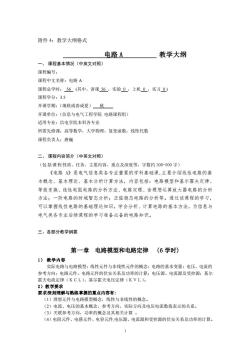
附件4:教学大纲格式 电路A 教学大纲 一、课程基本情况(中英文对照) 课程编号: 课程中文名称:电路A 课程总学时:56(其中,讲课56,实验0,上机0,实习0) 课程学分:3.5 开课学期:(填秋或春或夏)秋 开课单位:(信息与电气工程学院电路课程组) 适用专业:信电学院本科各专业 所需先修课:高等数学,大学物理,复变函数,线性代数 课程负责人:唐巍 二、课程内容简介(中英文对照) (包括课程性质、任务、主要内容、重点及深度等,字数约300-500字) 《电路A》是电气信息类各专业重要的学科基础课,主要介绍线性电路的基 本概念、基本理论、基本分析计算方法,内容包括:电路模型和基尔霍夫定律 等效变换、线性电阻电路的分析方法、电路定理、含理想运算放大器电路的分析 方法:一阶电路的时域暂态分析:正弦稳态电路的分析等。通过该课程的学习, 可以掌握线性电路的基础理论知识,学会分析、计算电路的基本方法,为信息与 电气类各专业后续课程的学习准备必备的电路知识。 三、各部分教学纲要 第一章电路模型和电路定律(6学时) 1)教学内容 实际电路与电路模型:线性元件与非线性元件的概念:电路的基本变量:电压、电流的 参考方向:电路元件,电路元件的伏安关系及功率的计算:电压源、电流源及受控源:基尔 霍夫电流定律(KCL)、基尔霍夫电压定律(KVL)。 2)教学要求 要求深刻理解与熟练掌握的重点内容有: (1)理想元件与电路模型概念,线性与非线性的概念。 (2)电流、电压的基本概念,参考方向,实际方向及电压电流数值表示的关系。 (3)关联参考方向,功率的概念及其相关计算。 (4)电阻元件、电感元件、电容元件,电压源、电流源和受控源的伏安关系及功率的计算
1 附件 4:教学大纲格式 电路 A 教学大纲 一、 课程基本情况(中英文对照) 课程编号: 课程中文名称:电路 A 课程总学时: 56 (其中,讲课 56 ,实验 0 ,上机 0 ,实习 0 ) 课程学分:3.5 开课学期:(填秋或春或夏) 秋 开课单位:(信息与电气工程学院 电路课程组) 适用专业:信电学院本科各专业 所需先修课:高等数学,大学物理,复变函数,线性代数 课程负责人:唐巍 二、 课程内容简介(中英文对照) (包括课程性质、任务、主要内容、重点及深度等,字数约 300-500 字) 《电路 A》是电气信息类各专业重要的学科基础课,主要介绍线性电路的基 本概念、基本理论、基本分析计算方法,内容包括:电路模型和基尔霍夫定律、 等效变换、线性电阻电路的分析方法、电路定理、含理想运算放大器电路的分析 方法;一阶电路的时域暂态分析;正弦稳态电路的分析等。通过该课程的学习, 可以掌握线性电路的基础理论知识,学会分析、计算电路的基本方法,为信息与 电气类各专业后续课程的学习准备必备的电路知识。 三、各部分教学纲要 第一章 电路模型和电路定律 (6 学时) 1) 教学内容 实际电路与电路模型;线性元件与非线性元件的概念;电路的基本变量;电压、电流的 参考方向;电路元件,电路元件的伏安关系及功率的计算;电压源、电流源及受控源;基尔 霍夫电流定律(KCL)、基尔霍夫电压定律(KVL)。 2)教学要求 要求深刻理解与熟练掌握的重点内容有: (1)理想元件与电路模型概念,线性与非线性的概念。 (2)电流、电压的基本概念,参考方向,实际方向及电压电流数值表示的关系。 (3)关联参考方向,功率的概念及其相关计算 。 (4)电阻元件、电感元件、电容元件,电压源、电流源和受控源的伏安关系及功率的计算
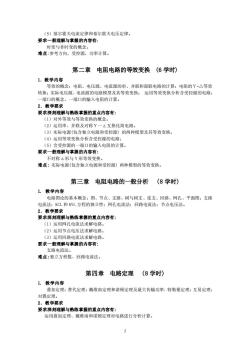
(5)基尔霍夫电流定律和基尔霍夫电压定律。 要求一般理解与掌握的内容有 时变 与非时变的概念 难点:参考方向,受控源,功率计算 第二章电阻电路的等效变换(6学时) 1.教学内容 等效的概念:电阻、电压源、电流源的串、并联和混联电路的计算:电阻的Y-△等效 转换:实际电压源、电流源的电路模型及其等效变换:运用等效变换分析含受控源的电路: 一端口的概念,一端口的输入电阻的计算。 2.数学要求 要求深刻理解与熟练握的重点内容有: (1)对外等效与等效变换的概念。 (2)运用串、并联及对称Y一△互换化简电路。 (3)实际电源(包含独立电源和受控源)的两种模型及其等效变换。 (4)运用等效变换分析含受控源的电路: )含受控源的一端口的输入电阻的计算 要求 般理解与掌的内容有 不对称△形与Y形等效变换。 难点:实际电源(包含独立电源和受控源)两种模型的等效变换。 第三章电阻电路的一般分析(8学时) 1.教学内容 电路图论的基本概念:图、节点、支路、树与树支、连支、回路、网孔、平面图:支路 电流法:KCL和KVL方程的独立性:网孔电流法:回路电流法:节点电压法。 2。教学要求 要求深刻理解与熟练举握的重点内容有: ()运用网孔电流法求解电路。 (2)运用节点电压法求解电路。 (3)运用回路电流法求解电路。 要求一般理解与掌握的内容有: 支路电流法。 难点:独立方程数、回路电流法, 第四章电路定理(8学时) 1.教学内容 叠加定理:替代定理:戴维南定理和诺顿定理及最大传输功率:特勒根定理:互易定理: 对偶定理 2.散学要求 要求深刻理解与熟练掌握的重点内容有: 运用叠加定理、戴维南和诺顿定理对电路进行分析计算
2 (5)基尔霍夫电流定律和基尔霍夫电压定律。 要求一般理解与掌握的内容有: 时变与非时变的概念。 难点:参考方向,受控源,功率计算。 第二章 电阻电路的等效变换 (6 学时) 1. 教学内容 等效的概念;电阻、电压源、电流源的串、并联和混联电路的计算;电阻的Y-△等效 转换;实际电压源、电流源的电路模型及其等效变换; 运用等效变换分析含受控源的电路; 一端口的概念,一端口的输入电阻的计算。 2.教学要求 要求深刻理解与熟练掌握的重点内容有: (1)对外等效与等效变换的概念。 (2)运用串、并联及对称Y一 Δ 互换化简电路。 (3)实际电源(包含独立电源和受控源) 的两种模型及其等效变换。 (4)运用等效变换分析含受控源的电路; (5)含受控源的一端口的输入电阻的计算。 要求一般理解与掌握的内容有: 不对称 Δ 形与 Y 形等效变换。 难点: 实际电源(包含独立电源和受控源) 两种模型的等效变换。 第三章 电阻电路的一般分析 (8 学时) 1. 教学内容 电路图论的基本概念:图、节点、支路、树与树支、连支、回路、网孔、平面图;支路 电流法;KCL 和 KVL 方程的独立性;网孔电流法;回路电流法;节点电压法。 2.教学要求 要求深刻理解与熟练掌握的重点内容有: (1)运用网孔电流法求解电路。 (2)运用节点电压法求解电路。 (3)运用回路电流法求解电路。 要求一般理解与掌握的内容有: 支路电流法。 难点:独立方程数、回路电流法。 第四章 电路定理 (8 学时) 1. 教学内容 叠加定理;替代定理;戴维南定理和诺顿定理及最大传输功率;特勒根定理;互易定理; 对偶定理。 2.教学要求 要求深刻理解与熟练掌握的重点内容有: 运用叠加定理、戴维南和诺顿定理对电路进行分析计算
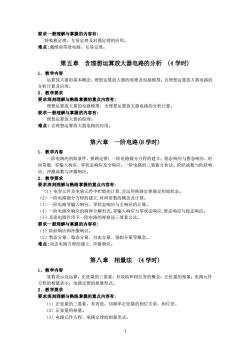
要求一般理解与掌握的内容有: 特勒根定理,互易定理及对偶定理的应用。 难点:戴维南等效电路,互易定理 第五章含理想运算放大器电路的分析(4学时) 1.散学内容 运算放大器的基本概念、理想运算放大器的原理及电路模型:含理想运算放大器电路的 分计算及应用。 2.教学要求 要求深刻理解与熱练掌握的重点内容有: 理想运算放大器的电路模型,含理想运算放大器电路的分析计算。 要求一般理解与举的内容有: 理想运算放大器 的原理 难点:含理想运算放大器电路的应用。 第六章一阶电路(8学时) 1.教学内容 阶电路的初始条件,换路定律:一阶电路微分方程的建立:稳态响应与暂态响应,时 间常数,零输入响应、零状态响应及全响应:一阶电路的三要素分析法:阶跃函数与阶跃响 应:冲激函数与冲激响应。 2,教学要求 要求深刻理解与慕练掌握的重点内容有: (1)电容元件及电感元件中贮能的计算,会运用换路定律确定初始状态。 (2)一阶电路微分方程的建立,时间常数的概念及计算。 (3)一阶电路零输入响应、零状态响应与全响应的计算。 (4)一阶电路全响应的两种分解形式,零输入响应与零状态响应,暂态响应与稳态响应。 (5)直流电源作用下一阶电路的视察法三要素公式。 要求一般理解与掌握的内容有: (1)阶跃响应和中激响应。 (2)暂态分量、稳态分量、自由分量、强制分量等概念。 难点:动态电路方程的建立,冲激响应。 第八章相量法(4学时) 1.敦学内容 复数表示及运算:正弦量的三要素,有效值和相位差的概念:正弦量的相量:电路元件 方程的相量表示:电路定律的相量形式。 2。教要求 要求深刻理解与熟练掌握的重点内容有: (1)正弦量的三要素,有效值,同频率正弦量的相位关系、相位差。 (2)正弦量的相量。 (3)电路元件方程、 电路定律的相量形式。 3
3 要求一般理解与掌握的内容有: 特勒根定理,互易定理及对偶定理的应用。 难点:戴维南等效电路,互易定理。 第五章 含理想运算放大器电路的分析 (4 学时) 1.教学内容 运算放大器的基本概念、理想运算放大器的原理及电路模型;含理想运算放大器电路的 分析计算及应用。 2.教学要求 要求深刻理解与熟练掌握的重点内容有: 理想运算放大器的电路模型,含理想运算放大器电路的分析计算。 要求一般理解与掌握的内容有: 理想运算放大器的原理。 难点: 含理想运算放大器电路的应用。 第六章 一阶电路(8 学时) 1.教学内容 一阶电路的初始条件,换路定律;一阶电路微分方程的建立;稳态响应与暂态响应,时 间常数,零输入响应、零状态响应及全响应;一阶电路的三要素分析法;阶跃函数与阶跃响 应;冲激函数与冲激响应。 2.教学要求 要求深刻理解与熟练掌握的重点内容有: (1)电容元件及电感元件中贮能的计算,会运用换路定律确定初始状态。 (2)一阶电路微分方程的建立,时间常数的概念及计算。 (3)一阶电路零输入响应、零状态响应与全响应的计算。 (4)一阶电路全响应的两种分解形式,零输入响应与零状态响应,暂态响应与稳态响应。 (5)直流电源作用下一阶电路的视察法三要素公式。 要求一般理解与掌握的内容有: (1)阶跃响应和冲激响应。 (2)暂态分量、稳态分量、自由分量、强制分量等概念。 难点:动态电路方程的建立, 冲激响应。 第八章 相量法 (4 学时) 1.教学内容 复数表示及运算;正弦量的三要素,有效值和相位差的概念;正弦量的相量;电路元件 方程的相量表示;电路定律的相量形式。 2.教学要求 要求深刻理解与熟练掌握的重点内容有: (1)正弦量的三要素,有效值,同频率正弦量的相位关系、相位差。 (2)正弦量的相量。 (3)电路元件方程、电路定律的相量形式
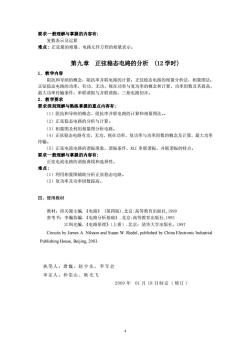
要求一般理解与掌握的内容有: 复数表示及运算 难点:正弦量的相量、电路元件方程的相量表示 第九章正弦稳态电路的分析(12学时) 1,教学内容 阻抗和导纳的概念,阻抗串并联电路的计算:正弦稳态电路的相量分析法,相量图法 正弦稳态电路的功率,有功、无功、视在功率与复功率的概念和计算,功率因数及其提高, 最大功率传输条件;串联谐振与并联谐振:三相电路初步。 2.教学要求 要求深刻理解与熟练掌握的重点内容有: (1)阻抗和导纳的概念、阻抗串并联电路的计算和相量图法。 (2)正弦稳态电路的分析与计算。 (3)相量图及利用相量图分析电路。 4)正弦稳态电路有功、无功、视在功率,复功率与功率因数的概念及计算,最大功率 传输。 (5)正弦电流电路的谐振现象,诺振条件,LC串联诰振、并联谐振的特点。 要求一般理解与掌握的内容有: 正弦电流电路的诰振曲线和选择性。 难点: (1)利用相量图辅助分析正弦稳态电路。 (2)复功率及功率因数提高。 四、使用教材 教材:邱关源主编.《由路》(第四版),北京:高竿教有出版社,1999 参考书:李瀚荪编。《电路分析基础》北京:高等教育出版社,1993 江缉光编。《电路原理》(上册).北京:清华大学出版社,1997 Circuits by James A.Nilsson and Susan W.Riede,published by China Electronic Industria Publishing House,Beijing.2003. 执笔人:唐巍、赵字先、李军会 审定人:仲崇山、歌光飞 2009年01月18日制定(修订)
4 要求一般理解与掌握的内容有: 复数表示及运算 难点: 正弦量的相量、电路元件方程的相量表示。 第九章 正弦稳态电路的分析 (12 学时) 1.教学内容 阻抗和导纳的概念,阻抗串并联电路的计算;正弦稳态电路的相量分析法,相量图法; 正弦稳态电路的功率,有功、无功、视在功率与复功率的概念和计算,功率因数及其提高, 最大功率传输条件;串联谐振与并联谐振;三相电路初步。 2.教学要求 要求深刻理解与熟练掌握的重点内容有: (1)阻抗和导纳的概念、阻抗串并联电路的计算和相量图法。 (2)正弦稳态电路的分析与计算。 (3)相量图及利用相量图分析电路。 (4)正弦稳态电路有功、无功、视在功率,复功率与功率因数的概念及计算,最大功率 传输。 (5)正弦电流电路的谐振现象,谐振条件,RLC 串联谐振、并联谐振的特点。 要求一般理解与掌握的内容有: 正弦电流电路的谐振曲线和选择性。 难点: (1)利用相量图辅助分析正弦稳态电路。 (2)复功率及功率因数提高。 四、使用教材 教材:邱关源主编.《电路》 (第四版).北京:高等教育出版社,1999 参考书:李瀚荪编.《电路分析基础》.北京:高等教育出版社,1993 江缉光编.《电路原理》(上册).北京:清华大学出版社,1997 Circuits by James A. Nilsson and Susan W. Riedel, published by China Electronic Industrial Publishing House, Beijing, 2003. 执笔人:唐巍、赵 宇 先、 李 军会 审定人:仲崇山、耿光飞 2009 年 01 月 18 日制定( 修订 )
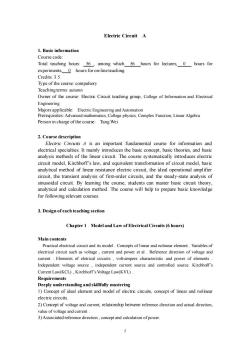
Eleetric Circuit A 1.Basic information Course code: Total teaching hours:56,among which 56 hours for lectures,0 hours for Type of the course:compulsory Teaching terms:autumn Owner of the course:Electric Circuit teaching group,College of Information and Electrical omplex Function,Linear Algebra Person in charge of the cours Tang Wei 2.Course description Electric Circuits A is an important fundamental course for information and electrical specialties.It mainly introduces the basic concept,basic theories,and basic analysis methods of the linear circuit.The course systematically introduces electric circuit model,Kirchhoff's law,and equivalent transformation of circuit model,basic uit,the ideal opera tional a circuit,the transient analysis of first-order circuits,and the steady-state analysis of sinusoidal circuit.By learning the course,students can master basic circuit theory, analytical and calculation method.The course will help to prepare basic knowledge for following relevant courses. 3.Design of each teaching section Chapter 1 Model and Law of Electrical Circuits(6 hours) Main content Practical electrical circuit and its model.Concepts of linear and nolinear element.Variables of electrical circuit such as voltage,current and power et al.Reference direction of voltage and current.Elements of eletrical circuits,volt-ampere characteristic and power of elements Independent voltage source,independent current source and controlled source.Kirchhoff's Current Law(KCL).Kirchhoff's Voltage Law(KVL) Requirements Deeply understanding and skillfully mastering 1)Concept of ideal element and model of elctric circuits,concept of linear and nolinear electric circuits. 2)Concept of voltage and current,relationship between reference direction and actual direction alue of voltage and 3)Associated reference direction,concept and calculation of powe 5
5 Electric Circuit A 1. Basic information Course code: Total teaching hours: 56 , among which 56 hours for lectures, 0 hours for experiments, 0 hours for on-line teaching. Credits: 3.5 Type of the course: compulsory Teaching terms: autumn Owner of the course: Electric Circuit teaching group, College of Information and Electrical Engineering Majors applicable: Electric Engineering and Automation Prerequisites: Advanced mathematics, College physics, Complex Function, Linear Algebra Person in charge of the course: Tang Wei 2. Course description Electric Circuits A is an important fundamental course for information and electrical specialties. It mainly introduces the basic concept, basic theories, and basic analysis methods of the linear circuit. The course systematically introduces electric circuit model, Kirchhoff’s law, and equivalent transformation of circuit model, basic analytical method of linear resistance electric circuit, the ideal operational amplifier circuit, the transient analysis of first-order circuits, and the steady-state analysis of sinusoidal circuit. By learning the course, students can master basic circuit theory, analytical and calculation method. The course will help to prepare basic knowledge for following relevant courses. 3. Design of each teaching section Chapter 1 Model and Law of Electrical Circuits (6 hours) Main contents Practical electrical circuit and its model . Concepts of linear and nolinear element . Variables of electrical circuit such as voltage , current and power et al . Reference direction of voltage and current . Elements of eletrical circuits , volt-ampere characteristic and power of elements . Independent voltage source , independent current source and controlled source. Kirchhoff’s Current Law(KCL) , Kirchhoff’s Voltage Law(KVL) . Requirements Deeply understanding and skillfully mastering 1) Concept of ideal element and model of electric circuits, concept of linear and nolinear electric circuits. 2) Concept of voltage and current, relationship between reference direction and actual direction, value of voltage and current . 3) Associated reference direction , concept and calculation of power
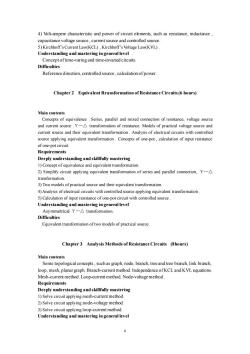
4)Volt-ampere characteristic and power of circuit elments.such as resistance.inductance capacitance voltage and source 5)Kirchhoff's Current Law(KCL),Kirchhoff's Voltage Law(KVL) Understanding and mastering in general level Concept oftime-varing and time-invaried circuits. Difficulties Referencedirection,controlled source,calculationof power Chapter 2 Equivalent Rransformation of Resistance Circuits(6 hours) Main contents Concepts of equivalence.Series,parallel and mixed connection of resistance.voltage source and current source.Ytransformation of resistance.Models of practical voltage source and current source and their equivalent transformation.Analysis of electrical circuits with controlled source applying equivalent transformation.Concepts of one-pot calculation of input resistance Deeply understanding and skillfully mastering 1)Concept of equivalence and equivalent transformation. 2)Simplify circuit applying equivalent ransformation of series and parallel connection,Y- 3)Tepraticaoue their cuiva 4)Analysis of electrical circuits with controlled source applying equivalent transformation 5)Calculation of input resistance of one-pot circuit with controlled source Understanding and mastering in general level Asymmetrical Y-A transformation. Difficulties Equivalent transformation oftwo models of practical source. Chapter 3 Analysis Methods of Resistance Circuits (8hours) Main contents Some topological concepts,suchas graph,node,branch,treeand tree branch.link branch. loop,mesh,planar graph.Branch-current method.Independence of KCLand KVL equations. Mesh-current method.Loop-current method.Node-voltage method. 1)Solve circuit applying mesh-current method 2)Solve circuit applying node-voltage method. 3)Solve circuit applying loop-current method. Understanding and mastering in general level 6
6 4) Volt-ampere characteristic and power of circuit elements, such as resistance, inductance , capacitance voltage source , current source and controlled source. 5) Kirchhoff’s Current Law(KCL) , Kirchhoff’s Voltage Law(KVL) . Understanding and mastering in general level Concept of time-varing and time-invaried circuits. Difficulties Reference direction, controlled source , calculation of power. Chapter 2 Equivalent Rransformation of Resistance Circuits (6 hours) Main contents Concepts of equivalence . Series, parallel and mixed connection of resistance, voltage source and current source .Y—△ transformation of resistance. Models of practical voltage source and current source and their equivalent transformation . Analysis of electrical circuits with controlled source applying equivalent transformation . Concepts of one-pot , calculation of input resistance of one-pot circuit. Requirements Deeply understanding and skillfully mastering 1) Concept of equivalence and equivalent transformation. 2) Simplify circuit applying equivalent transformation of series and parallel connection, Y—△ transformation. 3) Two models of practical source and their equivalent transformation. 4) Analysis of electrical circuits with controlled source applying equivalent transformation . 5) Calculation of input resistance of one-pot circuit with controlled source . Understanding and mastering in general level Asymmetrical Y—△ transformation. Difficulties Equivalent transformation of two models of practical source. Chapter 3 Analysis Methods of Resistance Circuits (8hours) Main contents Some topological concepts , such as graph, node, branch, tree and tree branch, link branch, loop, mesh, planar graph. Branch-current method. Independence of KCL and KVL equations. Mesh-current method. Loop-current method. Node-voltage method . Requirements Deeply understanding and skillfully mastering 1) Solve circuit applying mesh-current method. 2) Solve circuit applying node-voltage method. 3) Solve circuit applying loop-current method. Understanding and mastering in general level
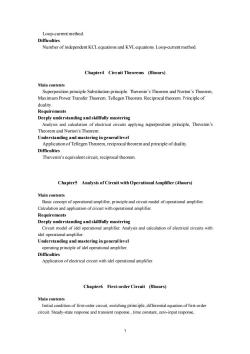
Loop-current method. Difficulties Number ofindependent KCLequations and KVLequations.Loop-current method Chapter4 Circuit Theorems (8hours) Main contents duality Requirements Deeply understanding and skillfully mastering Analysis and calculation of electrical circuits applying superposition principle.Thevenin's Theoremand Nortn's Theorem. Understanding and mastering in general level Application of Tellegen Theorem,reciprocal theorem and principle of duality. Difficulties Thevenin's equivalent circuit,reciprocal theorem Chapter5 Analysis of Circuit with OperationalAmplifier(4hours) Main contents Basic concept of operational amplifier,principle and circuit model of operational amplifier. Calculation and appliction of circuit with operational amplifier. Requirements Deeply understanding and skillfully mastering Circuit model of idel operational amplifier.Analysis and calculation of electrical circuits with idel operational amplifier. Understanding and mastering in general level ting principe of ide operational amplificr Application of electrical circuit with idel operational amplifier. Chapter6 First-order Circuit (Shours) Main contents Initiacndtionoffirst-order ciruitswitching principledifferentialqtionoffrstorde circuit.Steady-state response and transient response,time constant,zero-input response
7 Loop-current method. Difficulties Number of independent KCLequations and KVLequations. Loop-current method. Chapter4 Circuit Theorems (8hours) Main contents Superposition principle.Substitution principle. Thevenin’s Theorem and Norton’s Theorem, Maximum Power Transfer Theorem. Tellegen Theorem. Reciprocal theorem .Principle of duality. Requirements Deeply understanding and skillfully mastering Analysis and calculation of electrical circuits applying superposition principle, Thevenin’s Theorem and Norton’s Theorem. Understanding and mastering in general level Application of Tellegen Theorem, reciprocal theorem and principle of duality. Difficulties Thevenin’s equivalent circuit, reciprocal theorem. Chapter5 Analysis of Circuit with Operational Amplifier (4hours) Main contents Basic concept of operational amplifier, principle and circuit model of operational amplifier. Calculation and application of circuit with operational amplifier. Requirements Deeply understanding and skillfully mastering Circuit model of idel operational amplifier. Analysis and calculation of electrical circuits with idel operational amplifier. Understanding and mastering in general level operating principle of idel operational amplifier. Difficulties Application of electrical circuit with idel operational amplifier. Chapter6 First-order Circuit (8hours) Main contents Initial condition of first-order circuit, switching principle, differential equation of first-order circuit. Steady-state response and transient response , time constant, zero-input response
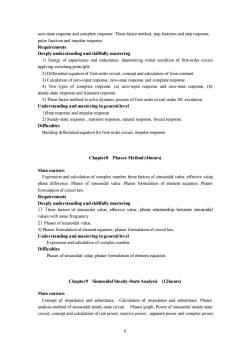
zero-state response and complete response.Three-factor method,step function and step response. pulse function and impulse response Requirements Deeply understanding and skillfully mastering 1)Energy of capacitance and inductance,determining initial condition of first-order circuit applying switching principle. 3)Calculation of zero-input response,zero-state response and complete response. 4)Two types of complete response:(a)zero-input response and zero-state response,(b) steady-state response and transient response. 5)Three-factor method to solve dynamic process of first-order circuit under DC excitation Understanding and mastering in general level 1)Step response and impulse response 2)Steady-state response,transient response,natural response,forced response Difficulties Building differential equation for first-order circuit,impulse response. Chapter8 Phasor Method(4hours) Main contents Expression and calculation of complex number,three factors of sinusoidal value,effective value phase difference.Phasor of sinusoidal value.Phasor formulation of element equation Phasor Requirements Deeply understanding and skillfully mastering 1)Three factors of sinusoidal value.effective value,phase relationship between sinusoida values with same frequency 2)Phasor of sinusoidal value 3)Phasor fo Understanding and mastering in general level Expression and calculation of complex number. Difficulties Phasor of sinusoidal value.phasor formulation of element equation. Chapter9 Sinusoidal Steady-State Analysis (12hours) Main contents Concept of impedance and admittance.Calculation of impedance and admittance.Phasor analysis method of sinusoidal steady-state circuit.Phasor graph.Power of sinusoidal steady-state circuit,concept and calculation of real power,reactive power,apparent power and complex power
8 zero-state response and complete response. Three-factor method, step function and step response, pulse function and impulse response. Requirements Deeply understanding and skillfully mastering 1) Energy of capacitance and inductance, determining initial condition of first-order circuit applying switching principle. 2) Differential equation of first-order circuit, concept and calculation of time constant. 3) Calculation of zero-input response, zero-state response and complete response. 4) Two types of complete response: (a) zero-input response and zero-state response, (b) steady-state response and transient response. 5) Three-factor method to solve dynamic process of first-order circuit under DC excitation. Understanding and mastering in general level 1)Step response and impulse response. 2) Steady-state response , transient response, natural response, forced response. Difficulties Building differential equation for first-order circuit, impulse response. Chapter8 Phasor Method (4hours) Main contents Expression and calculation of complex number, three factors of sinusoidal value, effective value, phase difference. Phasor of sinusoidal value. Phasor formulation of element equation. Phasor formulation of circuit law. Requirements Deeply understanding and skillfully mastering 1) Three factors of sinusoidal value, effective value, phase relationship between sinusoidal values with same frequency 2) Phasor of sinusoidal value. 3) Phasor formulation of element equation, phasor formulation of circuit law. Understanding and mastering in general level Expression and calculation of complex number. Difficulties Phasor of sinusoidal value, phasor formulation of element equation. Chapter9 Sinusoidal Steady-State Analysis (12hours) Main contents Concept of impedance and admittance . Calculation of impedance and admittance. Phasor analysis method of sinusoidal steady-state circuit. Phasor graph. Power of sinusoidal steady-state circuit, concept and calculation of real power, reactive power , apparent power and complex power
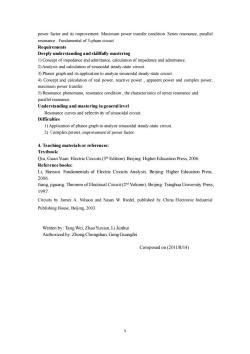
power factor and its improvement.Maximum power transfer condition.Series resonance.parallel resonance.Fundamental of 3-phase circuit Requirements Deeply understanding and skillfully mastering 1)Concept of impedance and admittance,calculation of impedance and admittance. 2)Analysis and calculation of sinusoidal steady-state circuit. 3)Phasor graph and its sy-state circuit 4)Concept and calculation of real power,reactive power apparent power and complex power. maximum power transfer 5)Resonance phenomano,resonance condition,the characteristics of series resonance and parallel resonance. Understanding and mastering in general level Res ce curves and of 1)Application of phasor graph to analyze sinusoidal steady-state circuit. 2)Complex power,improvement of power factor. 4.Teaching materialsor references: Textbook: Qiu,Guan Yuan.Electric Circuits(Edition)Beijing:Higher Education Press,2006 Reference books: Li,Hanxun.Fundamentals of Electric Circuits Analysis Beijing Higher Education Press, 2006. Jiang jiguang Theorem of Electrical Circuit Volume).Beijing:Tsinghua University Press 1997 Circuits by James A.Nilsson and Susan W.Riedel,published by China Electronic Industria Publishing House,Beijing.2003. Written by:Tang Wei,Zhao Yuxian,LiJunhui Authorized by:Zhong Chongshan,Geng Guangfei Composed on(2011/8/14)
9 power factor and its improvement. Maximum power transfer condition. Series resonance, parallel resonance . Fundamental of 3-phase circuit Requirements Deeply understanding and skillfully mastering 1) Concept of impedance and admittance, calculation of impedance and admittance. 2) Analysis and calculation of sinusoidal steady-state circuit. 3) Phasor graph and its application to analyze sinusoidal steady-state circuit. 4) Concept and calculation of real power, reactive power , apparent power and complex power, maximum power transfer. 5) Resonance phenomano, resonance condition , the characteristics of series resonance and parallel resonance. Understanding and mastering in general level Resonance curves and selectivity of sinusoidal circuit. Difficulties 1) Application of phasor graph to analyze sinusoidal steady-state circuit. 2) Complex power, improvement of power factor. 4. Teaching materials or references: Textbook: Qiu, Guan Yuan. Electric Circuits (5 th Edition). Beijing: HigherEducation Press, 2006. Reference books: Li, Hanxun. Fundamentals of Electric Circuits Analysis. Beijing: Higher Education Press, 2006. Jiang, jiguang. Theorem of Electrical Circuit (2 nd Volume). Beijing: Tsinghua University Press, 1997. Circuits by James A. Nilsson and Susan W. Riedel, published by China Electronic Industrial Publishing House, Beijing, 2003. Written by: Tang Wei, Zhao Yuxian, Li Junhui Authorized by: Zhong Chongshan, Geng Guangfei Composed on (2011/8/14)
按次数下载不扣除下载券;
注册用户24小时内重复下载只扣除一次;
顺序:VIP每日次数-->可用次数-->下载券;
- 《单片机原理与应用》课程教学课件(PPT讲稿)第3章 8051指令系统与编程基础.ppt
- 《单片机原理与应用》课程教学课件(PPT讲稿)第2章 AT89S51单片机硬件结构(1/2).ppt
- 《单片机原理与应用》课程教学课件(PPT讲稿)第2章 AT89S51单片机硬件结构(2/2).ppt
- 《单片机原理与应用》课程教学课件(PPT讲稿)第4章 AT89S52单片机的中断系统(1/2).ppt
- 《单片机原理与应用》课程教学课件(PPT讲稿)第5章 AT89S52单片机的定时器计数器(1/2).ppt
- 《单片机原理与应用》课程教学课件(PPT讲稿)第4章 AT89S52单片机的中断系统(2/2).ppt
- 《单片机原理与应用》课程教学课件(PPT讲稿)第5章 AT89S52单片机的定时器计数器(2/2).ppt
- 《单片机原理与应用》课程教学课件(PPT讲稿)第6章 AT89S52单片机的串行口(1/2).ppt
- 《单片机原理与应用》课程教学课件(PPT讲稿)第6章 AT89S52单片机的串行口(2/2).ppt
- 《单片机原理与应用》课程教学课件(PPT讲稿)ADDA电机(AT89S51单片机与DAC的接口).pptx
- 《单片机原理与应用》课程教学课件(PPT讲稿)DS18B20总线扩展技术.pptx
- 《单片机原理与应用》课程教学资源(学习资料)DS18B20测温头文件使用方法.docx
- 《单片机原理与应用》课程教学资源(授课教案)单片机定时/计数器模块.doc
- 《单片机原理与应用》课程教学资源(授课教案)AT89S52单片机的硬件组成、单片机的引脚功能(一).docx
- 《单片机原理与应用》课程教学资源(授课教案)3.7 8051汇编语言程序设计基础、3.8 汇编语言程序设计举例Keilc程序设计.docx
- 《单片机原理与应用》课程教学资源(授课教案)3.4 8051指令系统分类介绍、C语言中相关编程结构.docx
- 《单片机原理与应用》课程教学资源(授课教案)3.1 指令系统概述 3.2 指令格式 3.3 指令寻址方式 3.4 指令分类.docx
- 《单片机原理与应用》课程教学资源(授课教案)AT89S52单片机的硬件组成、单片机的引脚功能(二).docx
- 《单片机原理与应用》课程教学资源(授课教案)4.8 中断服务子程序的应用设计 4.9 多外部中断源的设计.docx
- 《单片机原理与应用》课程教学资源(授课教案)AT89S52定时计数器(1/4).docx
- 《电路》课程教学大纲 Electric Circuit B.doc
- 《电路》课程实验教学大纲 Experiment of Electric Circuit A.doc
- 《电路》课程实验教学大纲 Experiment of Electric Circuit B.doc
- 《电路》课程教学资源(实验指导)实验1 元件伏安特性.doc
- 《电路》课程教学资源(实验指导)实验5 RLC元件阻抗特性及交流等效参数的测定.doc
- 《电路》课程教学资源(实验指导)实验3 直流电路基本定理综合实验.doc
- 《电路》课程教学资源(实验指导)实验2 电源等效变换戴维南定理.doc
- 《电路》课程教学资源(实验指导)实验4 电路过渡过程的研究.doc
- 《电路》课程教学资源(实验指导)实验7 RLC串联谐振电路的研究.doc
- 《电路》课程教学资源(实验指导)实验6 日光灯电路及功率因数的提高.doc
- 《电路》课程教学资源(实验指导)实验8 RC选频网络特性的测试.doc
- 《电路》课程教学资源(实验指导)实验9 单相电度表的校验.doc
- 《电路》课程教学资源(实验指导)实验11 三相电路综合实验.doc
- 《电路》课程教学资源(实验指导)实验13 电阻温度计的制作.doc
- 《电路》课程教学资源(实验指导)实验12 二端口网络参数的测定.doc
- 《电路》课程教学资源(实验指导)实验14 运算放大器的应用.doc
- 《电路》课程教学资源(实验指导)实验10 互感与变压器.doc
- 《电路》课程教学资源(实验指导)实验15 移相器的设计与测试.doc
- 《电路》课程教学资源(实验指导)实验16 负阻抗变换器的制作和应用.doc
- 《电路》课程教学资源(实验指导)实验17 RC一阶电路动态特性的仿真.doc
